Nestled in the sacred hills of Tirumala, Tirupati is more than a pilgrimage — it is a living legacy of devotion and divine grace. From ancient Pallava endowments to the grandeur of the golden roof of the sanctum sanctorum donated by Krishna Deva Raya, its history is etched in every gopuram. Always reverbating with the chants of “Govinda”, for millions in South India, it is not just a temple, but an inseparable part of life’s journey.
Tirupati – A Sacred Legacy of Devotion and Divine Grace
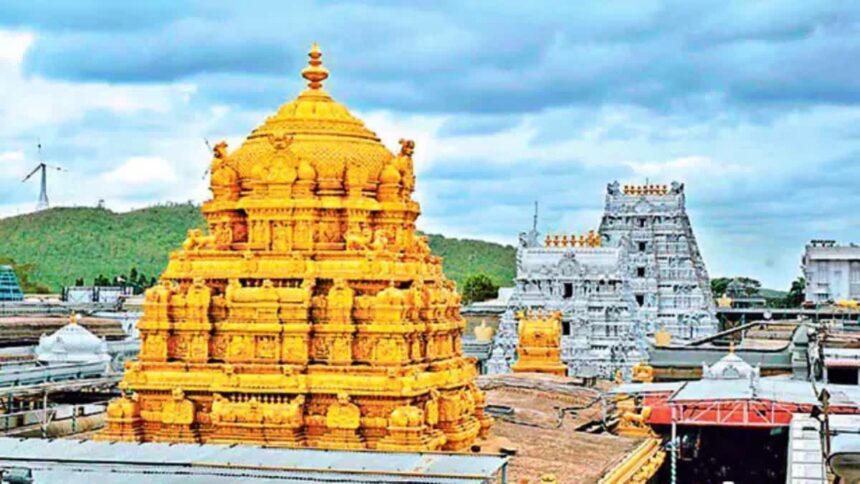
Tirupati, apart from being the abode of Shri Venkateswara, also was the place where I was born, and with which I have a close connect. For many of us in the Southern part of India, Tirupathi is a place which goes beyond the cliches of “richest Hindu temple” it is a place which is totally entwined with our lives. Be it marriage, or going abroad or an all-important examination or the birth of a new born, seeking the blessings of Lord Venkateshwara, the presiding deity of Tirupati is a must. For all newly married couples in the South, a trip to Tirupathi is mandatory, to seek the blessings of the lord, with the exception of Kerala, where most of them go to Guruvayoor. And the same goes for all new born, whom their parents bring to Tirupathi, for blessings.
Srinivas, a name of the Lord meaning, one in whom Sri (or Lakshmi , the Goddess of Wealth)resides, is as common a name in the Southern part of India, as i guess Smith is in England. Other names of the Lord like Venkateshwara, Balaji, Seshadri, Venkata Ramana are quite common names down South too. Like myself, the Lord is the family deity for many down South. Visit the home of any person from Andhra, Tamil Nadu or Karnataka, and you are sure to find, a calendar of the Lord, or an image in the Puja room. For most of us down South, Tirupathi is not just a temple, not just a place, it is a part of our life.
I had been to Tirupathi quite a number of times, but for me the most awe inspiring sight will always be the multitudes of pilgrims, chanting the name of the Lord in unison. “Yedukondalavada Govinda” (in Telugu) or “Yezhu Malai Govinda” (in Tamil) refers to the Lord of the 7 hills. Other popular chants for the Lord are “Anandha Rakshaka Govinda” (Protector of the Orphaned and Helpless), “Apada Mokkula Vada Govinda” (One who grants the wishes of his devotees).
The pilgrims themselves make a fascinating mix – barefooted villagers, jeans clad yuppies, old men and women, prosperous businessman, blue collar workers, young teenage girls, middle aged mamis from Chennai, newly married couples – you find persons from every caste, class and creed thronging the hills. Per day, an average of 60,000 pilgrims visit the temple, and during the festival season of Brahmotsavam during Dussehra time, it shoots up to 100,000 per day on an average.
Tirupathi is often a common name used to refer to the twin towns of Tirupathi and Tirumala. Tirupathi is located near the foothills and is a sprawling town by itself. The main temple of Shree Venkateshwara is located on the seven hills of Tirumala, a corruption of the Tamil word, Tirumalai, meaning the Hill where the Lord resides.
Tirumala is located on the seven hills bearing the names of Vrishabadri, Venkatadri, Narayanadri, Seshadri, Anjanadri, Garduadri and Neeladri. Vrishabadri is named after an Asura Vrushaba killed by Srinivasa. Anjanadri after Hanuman. Neela after Neela Devi, a devotee of Shri Venkateswara. Garuda after Garuda, Shesha after Adi Shesha. Narayanadri is where the Srivari Padalu are believed to be located and Venkatadri is where Tirumala is located.
Incidentally the practice of tonsuring at Tirumala, as Mokku, is related to Neela Devi, a devotee of Shri Venkateswara. Apparently when Srinivasa was hit by a cowherd, a small portion of his scalp became bald. Neela a Gandharva princess, cut a part of her hair and placed it there. Venkateswara blessed Neela Devi saying that whoever comes to Tirumala would offer their hair to him, and she would be the recipient of all the hair. Hence when you are donating your hair in Tirumala, in effect it is for Neela Devi.
The trek starts at Alipiri, and the first stage is one of the toughest. The steepest point is touched here at Alipiri Mettu, this part is colloquially nicknamed as Mokallaparvatam (or the mountain of knees), due to the fact that your knees often touch the steps here.
After you cross the first stage, the rest of the path, is somewhat even, and one can walk along admiring the beauty of the nature, and the hills and valleys around. There are refreshments all along the path, where one can have cool drinks, juices or snacks, to keep going along. There is also a lovely deer park, and do stop for some time to take a view of the Chandragiri valley. It is just beautiful. The last part of the trek is again quite a steep climb, and can be very exhausting. This could be metaphorically taken also as the fact that the first and last stages of life are the toughest ones.
Hindu philosophy has 4 ages- Satya, Treta, Dwapara and Kali, or what are called the 4 Yugas. It is believed that Lord Vishnu appeared on Earth during those Yugas in various avatars or reincarnations. During Treta Yuga it was as Rama, during Dwapara Yuga it was as Krishna, and during Kali Yuga, it is believed to be as Venkateshwara.
We have the now popular legend of Vishnu, comming down to earth in search of his consort Lakshmi, after she had left Vaikuntha, following a dispute. Lord Vishnu in his wanderings as an ascetic, falls in love with Padmavathi, the daughter of the local chieftain Akasaraja. He sends a marriage proposal through Vakula Devi, who happens to be a reincarnation of Yashoda, Krishna’s foster mother. On hearing the news from Vakula Devi, the king gladly consents and thus the marriage of Srinivasa and Padmavathi is performed with blessings of the Gods. On the request of his devotees, the Lord consents to stay on earth during the entire period of Kaliyuga.
It is one of the 108 Divya Desams, and one of the 8 temples where Vishnu manifested himself in Swayambhu form, the others being Badrinath, Naimisharanya, Muktidham in Nepal.
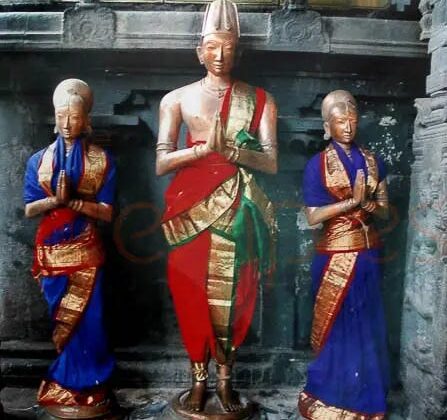
The first recorded endowment was made by Samavai, a Pallava queen around 966 CE, who also built the original temple. Many dynasties like the Pallavas, the Cholas and the Hoysalas contributed to the building of the temple, and gave it generous grants.
The temple however reached it’s peak of glory during the Vijayanagar empire period in the 14th century. Sri Krishna Deva Raya, the great Emperor, was the one who donated Gold and Jewels to the temple, and he was responsible for the golden roof of the sanctum sanctorum.
In Tirumala temple, one can can see idols of the emperor along with his 2 wives. Chandragiri near Tirupathi, was a second capital of the Vijayanagara empire, while the emperors would hold their coronation ceremonies at Tirumala.
Also when Srirangam was attacked by Malik Kafur in 1310–11 AD, the main deity Ranganatha Swamy was shifted to Tirumala , and preserved there at the Ranganayaka Mandapam till it was taken back to it’s original abode.
The gold plated gopuram over the central sanctum sanctorum is called as Ananda Nilayam. As per Vaishnavas, the gopuram at Srirangam is named as Pranavakara Vimana due to being shaped like Om, and that at Varadaraja Temple, Kanchi as Punyakoti Vimanam.
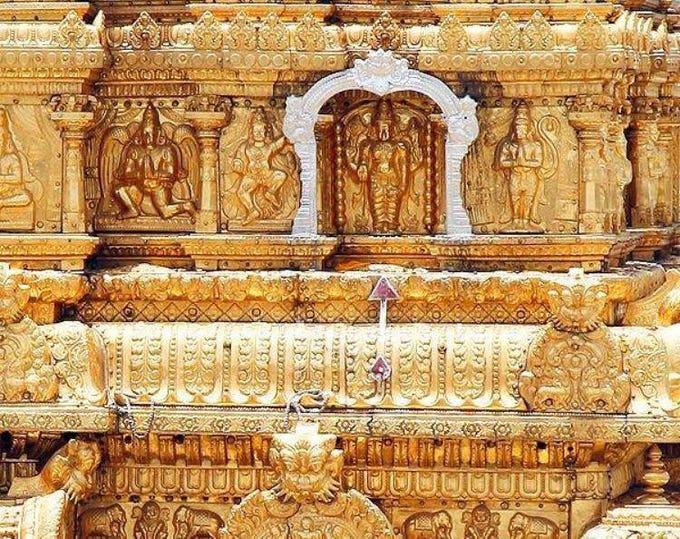
The Ananda Nilayam has a smaller deity called as Vimana Venkateswara. Rishi Vyasa Theertha is believed to have attained moksha praying here, reason why devotees pray here, after doing darshan of main deity.
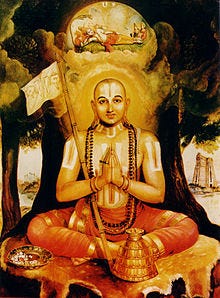
Ramanujacharya visited Tirupati thrice, first with his uncle Tirumalai Nambi, second to settle a dispute between Shaivaites and Vaishnavas. It was during his 3rd visit, that he installed the deity of Govindaraja, which was the foundation for Tirupati town.
It was Ramanujacharya who defined the rituals at Tirumala as per the Vaikhanasa Agama tradition and introduced the recitation of the Naalayira Divya Prabandham there. Also set up the Tirumala Jeeyar Matha there. In 1834, the East India Company, transferred the administration of Tirumala Temple to the Hathiramji Matha who acted as Vicaranakartas. Until the Act of 1933, that created TTD and placed it in the hands of then Madras Government, and later came under Andhra Pradesh Govt.
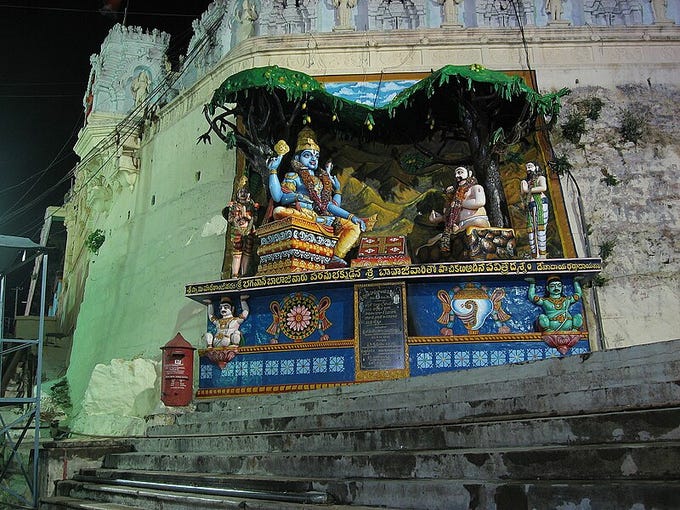
Hathiram Bhavaji, was one of Shri Venkateswara’s most well known devotees, hailing from Ayodhya. On his travels, he decided to reside at Tirupati, and set up an ashram here, which became the Hathiram Bhavaji Matha.
It’s believed that Shri Venkateswara pleased with his devotion would come and play dice daily with Bhavaji. One day realising he had spent too much time in the game, Venkateshwara rushed back, forgetting one of his ornaments in a hurry with Bhavaji.
When Bhavaji tried to return the ornament, he was arrested and bought before the king. He tried to narrate the previous night’s incident, however the king refused to believe him, and ordered his servants to fill his home with sugarcane, and eat it all over the night.
As Bhavaji chanted Shri Venkateswara’s name, he came in the form of an elephant, and ate up all the sugarcane. The King realized that it was God himself who came down, and made Bhavaji the supervisor of the temple. And that is how he got the name of Hathiram Bhavaji.
The Hathiram Bhavaji Matha used to administer Tirumala between 1843-1932 till TTD was formed, and even now it is still there just next to the temple. Also Hathiram is believed to have gone into Samadhi on his own accord.
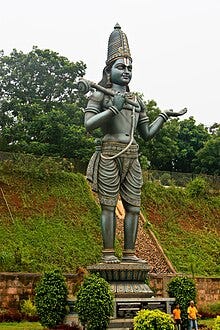
Other famous devotee of Shri Venkateswara was Tallapaka Annamacharya more popularly known as Annamayya. He composed 32000 keerthanas in praise of the Lord, and made use of Sringara to describe the love of Venkateswara and Padmavati.
The Mahadwaram at Tirumala Temple is flanked by two panchaloha statues of Sankanidhi and Padmanidhi who are believed to be the guardians of the Lord’s treasure. Also called Padikavali or Simha Dwaram.
The Pradaksihna area around the temple is called Sampangi Pradakshina, as the Sampangi flowers were grown here. This contains all the famous Mandapams, including the Ranganayakula Mandapam, Addala Mandapam, Kalyanotsava Mandapam, Ugranam (Store House), Balipetam and Tulabharam.
Vendi Vakili (Silver Threshold) is the 2nd entrance, as the doors here are plated with Silver, this leads to Vimana pradakshina around the Ananda Nilayam. This area includes the Pottu (Kitchen), Bangaru Bavi (Golden Well), Yagasala as well as minor shrines.
Tirumamani Mandapam right in front of Bangaru Vakili (Golden Threshold), from where one can enter the inner sanctum sanctorum, flanked by Jaya and Vijaya. The Suprabhatam is sung here by priests.
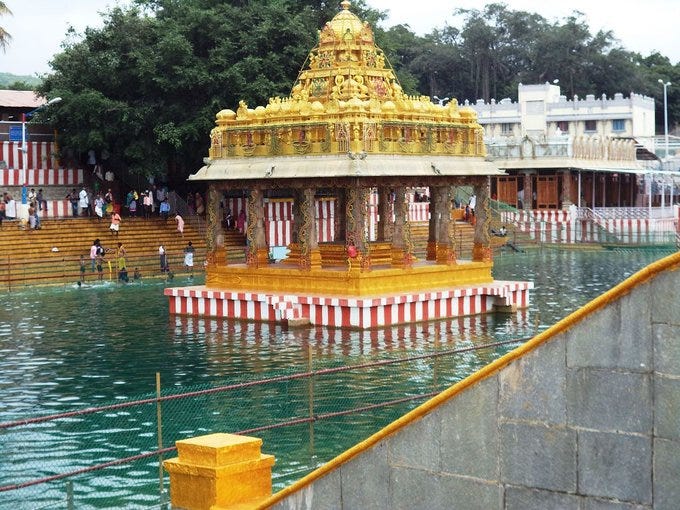
The Srivari Pushkarini or Swami Pushkarini is believed to have been brought by Garuda from Vaikuntham. The Mandapam in the center was constructed by Saluva Narasimha Raya in 1468, and every evening you have a Pushkarni Harathi here.
Shri Venkateshwara is represented by Pancha Beramulu, the Moolvirat in Garba Gruham is called Dhruva Beramu. Bhoga Srinivasa or Katuka Beram is placed near left foot of Moolvirat.
Ugra Srinivasa or Snapana Beram is kept in sanctum sanctorum, and is taken out in a procession once in a year. The processional deity is Malayappa Swami or Utsava Beram, which is taken out during all the festivals.
The smaller shrines in Tirumala are
Varadaraja Temple – Located towards the west of the Vendi Vakili (Silver Threshold), it has Vishnu in the form of Varadaraja Swamy, sitting and facing west.
Yoga Narasimha Temple – This is on the right of the Vendi Vakili, dedicated to Narasimha in a sitting posture.
Garuthmantha Temple – This is dedicated to Garuda, exactly opposite the Bangaru Vakili or Golden Threshold.
Bhuvaraha Swamy Temple – Considered to be older than the main temple, lies on northern banks of the Swami Pushkarni. As per tradition, naivedyam is first offered to Bhuvaraha Swamy before being offered and devotees generally have his darshan before visiting the main temple.
Bedi-Anjaneya Temple – This is located exactly opposite to the Mahadwaram, dedicated to Hanuman, the deity here has both his hands tied up.
Vakulamatha Sannidhi – As per Puranas, she is the mother of Venkateswara, and her statue is there just before the Varadaraja shrine in the main temple. It’s believed she supervises the preparation of food to be offered to her son, and so there is a hole in the wall separating her shrine and the Srivari Pottu (Kitchen).
The Annadana Kendra, that feeds thousands of devotees daily in Tirumala, is named after Tarigonda Vengamamba, a devotee of Shri Venkateswara, who wrote many songs and poems in his praise. There is a special harathi to the Lord in her name every day.
This is not an exhaustive summary of Tirumala. The place actually has so much history and heritage, not just the main temples, but even the surrounding areas, that it would need one whole book on it. What I have shared here is just a humble tribute to the place of my birth, with which I will always have a special bonding.

Leave a Reply